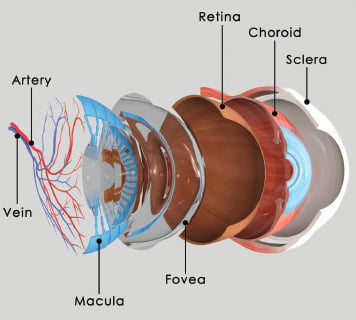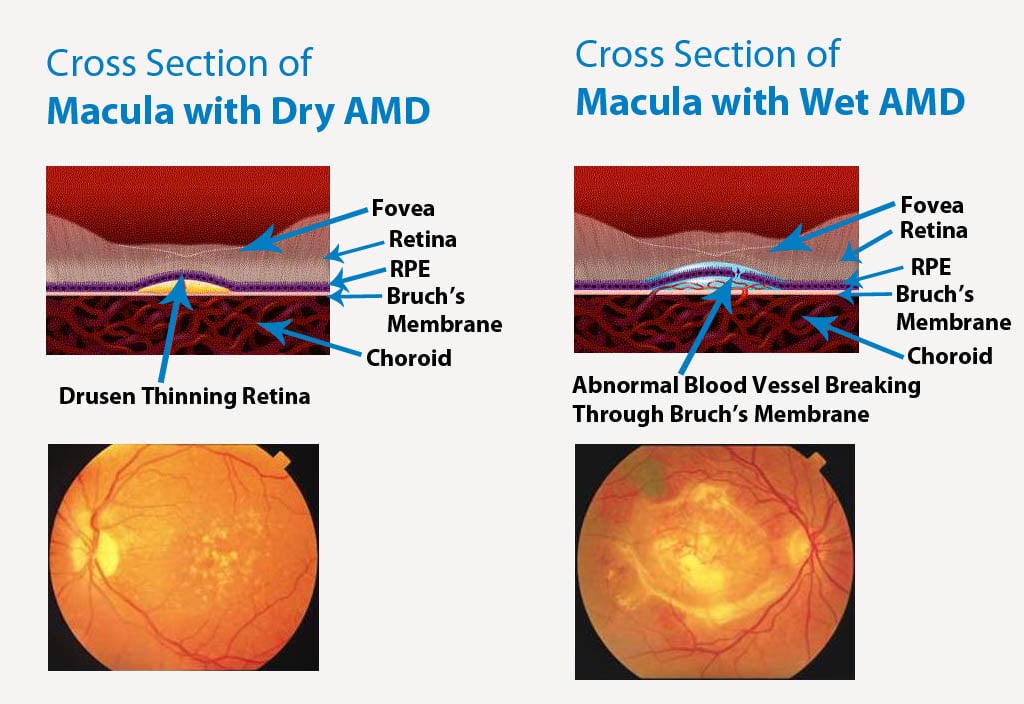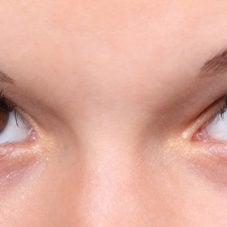The treatments so far available for Macular Degeneration (also known as Age-Related Macular Degeneration or AMD) have only been able to slow the disease’s progress. In this article, we are going to look at the latest exciting research into omega-3 and macular degeneration, as well as diet and lifestyle factors that can also contribute to the condition.
Fish oil is natural, safe, and effective, but just how effective we will discover towards the end of this article, but first to understand why fish oil is so useful for the eye we need to take a quick overview of what macular degeneration is, and current attempts to treat it.
If you already have a clear understanding of AMD, its causes, symptoms and wet vs dry types, please feel free to skip down to the treatments section to see the latest research and advice by clicking the link below.
Treating AMD
What is Macular Degeneration?

AMD is a common condition that normally affects older adults. It affects tissue in the part of your retina that is responsible for central vision called the macula. It often causes blurred vision or a blind spot in the center of your vision. It can affect a number of daily activities such as driving and reading, and many people first notice it when they need more light to see objects closely. Currently, there is no known cure for macular degeneration, only treatments to slow its progress. That is why the latest research into omega-3 and macular degeneration is so exciting as we will see later.
What Causes AMD?
No one is exactly sure what causes macular degeneration, but it seems to be a combination of lifestyle factors including diet, stress and smoking, the aging of the eye, and probably a genetic susceptibility.
There are certain risk factors that mean you are more likely to develop macular degeneration. They are:
- Age – Over 65’s are at a greater risk
- Race – The condition is more likely to affect white people
- Obesity – Although not necessarily a cause in itself, being overweight does increase the chance that the disease will progress from early to late stage AMD
- Family History – Genetic susceptibility likely plays a role; if someone in your family has suffered from the condition, you may be at a higher risk
- Cardiovascular problems – If you’ve had heart or CV issues in the past you may be at a higher risk, as these will affect the blood supply, (and therefore nutrient supply), to the eyes.
Wet Macular Degeneration vs Dry
Macular degeneration can be both “Wet” and “Dry”.
Dry AMD affects about 85% of people with macular degeneration and begins with characteristic yellow deposits (drusen) in the macula. These occur between the retinal pigment epithelium and the underlying Choroid. People with Dry AMD may not develop advanced degeneration. However, the retinal pigment layer may degenerate which results in a loss of the photoreceptors (rods and cones) and vision loss, but this is usually gradual.
Wet AMD causes vision loss because of the growth of blood vessels in the retina. The blood vessels are very fragile and when they break they can leak both blood and protein below the macula. The leaking, bleeding, and scarring that results from this can damage the photoreceptors, and potentially lead to a much more rapid vision loss, which can become serious if it’s not treated.
What Macular Degeneration Looks Like

AMD Symptoms
- Visual Distortions – Straight lines can become bent.
- Reduced Central Vision – This can occur in just one or both eyes.
- Needing Brighter Light – When reading or doing other activities.
- Difficulty Recognising Faces – You may not recognize things that should be very familiar to you.
- Difficulty adjusting to low light levels – When you enter a room or area with lower light levels than the place you have been in, you may have difficulty adjusting.
- Decreased brightness of Intensity of Colour – Colours that once seemed vivid may lose their shine.
- Increased Blurriness of Writing – Books, newspapers and other places with the written word may appear more blurry.
Omega-3 and Macular Degeneration: Treatment and Prevention
Current pharmaceutical interventions for wet AMD include angiogenesis inhibitors that work by blocking vascular endothelial growth factor (VEGF), which is what promotes the blood vessel growth characteristic of wet AMD. Current drugs include Eylea, Lucentis, Macugen, and Avastin, although these drugs can only slow the progress of the disease.
However despite this, for dry AMD and in the prevention of wet AMD there is significant hope for a far more positive outcome. Omega-3 and specifically, the Omega-3 fatty acid DHA plays a central role in the whole development of the central nervous system. DHA is particularly important in the brain and the eye, and it’s especially important in the retina of the eye, where the neuronal photoreceptor cells that make vision possible have the highest concentrations of DHA of any cell in the body.
DHA has a special chemical composition with 6 double bonds that give it extra fluidity and flexibility, so when it’s incorporated into the phospholipid layers of the photoreceptors it allows them to effectively react to incoming light. This means the photoreceptors can then transfer the signals to the brain so we can see.
Studies On Wet and Dry Macular Degeneration Prevention with Omega-3
Now we can look at the scientific studies on omega-3 and macular degeneration. So far 4 comprehensive studies have shown that higher intakes of omega-3 rich food, i.e fish, correlate with lower levels of macular degeneration, and all of them conclude that increasing intake of dietary omega-3 can prevent developing macular degeneration (1-4). The third study showed that eating a lot of fish can also slow macular degeneration progressing to advanced levels (2-3). The fourth study found that eating oily fish once a week can cut the risk of developing macular degeneration by 50% (4).
How To Cure AMD – Is Fish Oil An Effective Macular Degeneration Supplement?
Now that we’ve seen that higher intakes of omega-3 in your diet reduce macular degeneration risk, and can also slow its progress, what effect does adding a highly concentrated omega-3 supplement have on the disease?
There have so far been 3 long-term studies on the effects of supplementing omega-3 fish oil on Macular degeneration. There is a clear pattern of the effectiveness of omega-3 and macular degeneration treatment, depending on the dose of omega-3 that the study participants were given. The more omega-3 you take the better the results.
The first study in May 2013 gave participants a relatively small dose of 650mg eicosapentaenoic acid (EPA) per day and 350 mg docosahexaenoic acid (DHA) per day for a total of 1 gram of omega-3. The study participants continued to take this dose for between 4 and 5 years. The authors of the study found that this dosage of omega-3 did not slow or reduce the risk of progression to the advanced stage of macular degeneration (5).
The second study increased the dose slightly to 1110mg of omega-3 a day, and the participants took this dose for 3 years. However, the dose did contain a much higher amount of DHA at 840mg as opposed to 350mg in the previous study. DHA, as we’ve seen, is the omega-3 fatty acid most vital to the function of the retina. The authors of the study found that in those individuals that had the highest red blood cell levels of DHA, there was a 68% reduced risk of new blood vessel formation, although they found there was no actual improvement in eyesight (6).
The 3rd study used a much larger dose of 3.4 grams of EPA and 1.6 grams of DHA for a total daily dose of 5 grams of omega-3 per day. This study lasted just 6 months. However, after eyesight testing, 100% of the study participants affected by dry AMD achieved a significant improvement in their eyesight!
The eyesight testing took place on a standard letters chart, where five letters on a line are progressively reduced in size until one can no longer read any of the letters. One-third of the study participants saw one line of improvement in their vision (i.e 5 letters), the next third saw 2 lines of improvement in their visions (i.e 10 letters), the last third saw 3 lines of improvement in their visions (i.e 15 letters). What makes this study so remarkable is that it’s actually showed that high dose omega-3 can begin to restore eyesight in people suffering from Age-Related Macular Degeneration, when previously all treatments have only been able to slow the disease progress. All participants saw an improvement in their eyesight within 4.5 months of starting to supplement with omega-3, and some of the participants started to see an improvement within days (7).
If you currently are suffering from dry AMD and are looking for an extremely high-quality omega-3 fish oil with a very high-quality DHA component please check out our Ultra Pure Omega-3 Fatty Acids supplement. We recommend starting with a daily 3 capsule serving.
Other Supplements and Vitamins For Macular Degeneration
The AREDS study (8) and the AREDS study 2 (5), have also identified other antioxidants and minerals that can prevent the development of macular degeneration to advanced levels. The 2nd AREDS study identified that the following vitamins and minerals (and dosages) can reduce the risk of advanced AMD and vision loss.
- 500 mg of vitamin C
- 400 IUs of vitamin E
- 10 mg of lutein
- 2 mg of zeaxanthin
- 80 mg of zinc
- 2 mg of copper
As well as omega-3, they are certainly worth adding to any supplement regime for those suffering from AMD.
Macular Degeneration Diet and Lifestyle
An effective diet for AMD involves eating lots of fruit and vegetables as well as cutting out processed foods and refined sugar. Try to include eating fish regularly or if that’s not possible supplementing with a high dose high-quality omega-3 fish oil. Also try supplementing with the regime above, although a high quality ‘clean’ diet should already allow you to get these vitamins and minerals in the dosages required.
So far studies have indicated that high saturated fat intake is associated with developing AMD. However, the studies don’t identify between people eating ‘unhealthy’ saturated fat – think burgers, hotdogs and donuts, and those eating more ‘healthy’ saturated fat – i.e grass-fed meats. However, moderation here is probably key.
Smoking is also strongly associated with AMD so give it up! Also, make sure to add some exercise into your schedule. Both giving up smoking and exercising will help weight loss if it’s needed. It will also help the cardiovascular system become more efficient and improve blood flow to the eyes. As we’ve seen above obesity and CV issues are both risk factors for developing AMD and it’s progression to advanced levels.
References
- Seddon JM, Cote J, Rosner B. Progression of age-related macular degeneration: association with dietary fat, transunsaturated fat, nuts, and fish intake [published correction appears in Arch Ophthalmol. 2004 Mar;122(3):426]. Arch Ophthalmol. 2003;121(12):1728‐1737.
- Cho E, Hung S, Willett WC, et al. Prospective study of dietary fat and the risk of age-related macular degeneration. Am J Clin Nutr. 2001;73(2):209‐218.
- Reynolds R, Rosner B, Seddon JM. Dietary omega-3 fatty acids, other fat intake, genetic susceptibility, and progression to incident geographic atrophy. Ophthalmology. 2013;120(5):1020‐1028.
- Augood C, Chakravarthy U, Young I, et al. Oily fish consumption, dietary docosahexaenoic acid and eicosapentaenoic acid intakes, and associations with neovascular age-related macular degeneration. Am J Clin Nutr. 2008;88(2):398‐406.
- Age-Related Eye Disease Study 2 Research Group. Lutein + zeaxanthin and omega-3 fatty acids for age-related macular degeneration: the Age-Related Eye Disease Study 2 (AREDS2) randomized clinical trial [published correction appears in JAMA. 2013 Jul 10;310(2):208]. JAMA. 2013;309(19):2005‐2015.
- Souied EH, Delcourt C, Querques G, et al. Oral docosahexaenoic acid in the prevention of exudative age-related macular degeneration: the Nutritional AMD Treatment 2 study. Ophthalmology. 2013;120(8):1619‐1631.
- Georgiou T, Neokleous A, Nicolaou D, Sears B. Pilot study for treating dry age-related macular degeneration (AMD) with high-dose omega-3 fatty acids.PharmaNutrition. 2014;2(1):8-11.
- Age-Related Eye Disease Study Research Group. A randomized, placebo-controlled, clinical trial of high-dose supplementation with vitamins C and E, beta carotene, and zinc for age-related macular degeneration and vision loss: AREDS report no. 8 [published correction appears in Arch Ophthalmol. 2008 Sep;126(9):1251]. Arch Ophthalmol. 2001;119(10):1417‐1436.






